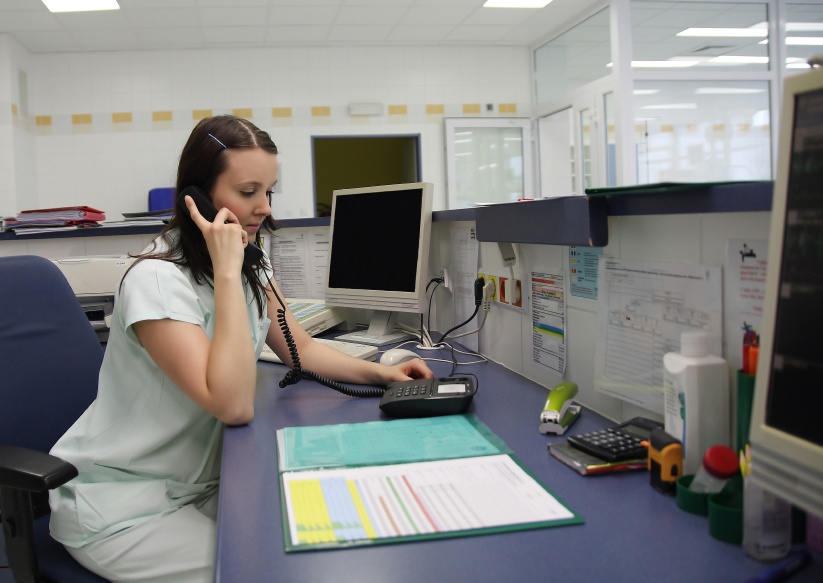Updated December 2025
Over the past few years, telehealth has emerged as a powerful tool for delivering care. This shift toward virtual consultations has demonstrably improved patient access, convenience, and overall satisfaction. However, the rise of telehealth also presents new realities for medical office administrators and assistants (MOAs).
In this post, we delve into the growing influence of telehealth and explore its impact on MOA roles and responsibilities. We examine the evolving skillsets required for success in this dynamic environment and offer strategies to help you navigate the changing healthcare landscape.
TABLE OF CONTENTS
- The Telehealth Boom
- Common Telehealth Technologies and Practices
- Impact on Medical Office Administrators
- Essential Skills for the Telehealth Era
- Predictions and Trends
- Importance of Adaptability and Lifelong Learning
THE TELEHEALTH BOOM
Telehealth refers to the practice of using telecommunications technology (i.e., phone, video, text) to deliver healthcare consultations and services remotely. It’s commonly known as virtual care.
This type of distance care has been around for decades, but it really took off when COVID hit and physical distancing measures limited in-person interactions. Many provincial governments temporarily changed the healthcare regulatory compliance framework, allowing physicians to bill the public healthcare system for telehealth services. That made it easier for providers to offer and for patients to access these services.
Telehealth has significant benefits. It expands access to healthcare services, particularly for those in remote or underserved areas. Patients no longer need to travel or sit in a waiting room with other sick people. The convenience of online healthcare services has been especially appealing to people with mobility issues or those seeking immediate attention.
A 2021 survey by Leger and Canada Health Infoway found that 73 per cent of people had had at least one virtual interaction with a healthcare professional and 90 per cent were satisfied with the experience.
In many cases, patients prefer virtual visits. A 2022 survey of U.S. patients who had used telehealth found that:
- 80 per cent preferred it for prescription refills
- 72 per cent preferred it for reviewing medication options
- 71 per cent preferred it for discussing test results
- 57 per cent preferred it for regular mental health visits
 A high percentage of patients prefer virtual visits
A high percentage of patients prefer virtual visits
COMMON TELEHEALTH TECHNOLOGIES AND PRACTICES
There are three main ways medical offices are implementing telehealth in healthcare.
Real Time
This is a synchronous form of telehealth, in which providers and patients connect live through telephones or secure video platforms. It’s similar to an in-person visit, except that you interact through electronic means.
Store and Forward
This is an asynchronous method of communication in which digital images, videos, or lab reports are sent to a healthcare provider for remote evaluation. For instance, a patient might send a picture of a rash to be reviewed by a dermatologist. Patients and providers never actually interact in real time.
Remote Patient Monitoring (RPM)
This involves remotely collecting medical data through the use of digital devices like smartwatches, blood pressure monitors, and blood glucose meters. The data is transmitted to healthcare providers, and automated systems send an alert when intervention may be necessary. Remote patient management is particularly useful for chronic conditions such as diabetes or heart disease.
IMPACT ON MEDICAL OFFICE ADMINISTRATORS
The rise of telehealth has significantly impacted the way medical office administrators and assistants (MOAs) do their jobs. Here are a few ways in which MOA roles and responsibilities are adapting to virtual healthcare delivery:
Scheduling and Coordination
MOAs often need to schedule and coordinate telehealth appointments. In some cases, that means triaging patients to determine if a telehealth appointment is appropriate or if an in-person visit is necessary.
MOAs are also in charge of integrating virtual visits into existing schedule systems to avoid conflicts and sending appointment reminders with clear instructions on how to join the virtual consultation.
In addition, some workflow changes may become necessary as MOAs find themselves managing a higher volume of shorter virtual appointments compared to in-person visits. You must coordinate between the two types of appointments and ensure that healthcare providers’ schedules are optimized for each.
Technical Support
MOAs play a critical role in educating patients on how to access and use telehealth services. They have also become the first line of support for patients who may be experiencing technical difficulties with telehealth platforms. You need to be prepared to assist patients with the setup and use of video conferencing software, troubleshoot connection issues, and ensure that patients have the necessary equipment and bandwidth.
Billing and Insurance
Telehealth has introduced new billing codes and reimbursement policies that MOAs need to be familiar with. You are responsible for verifying insurance coverage for telehealth services, processing billing accurately, and handling insurance-related queries from patients.
ESSENTIAL SKILLS FOR THE TELEHEALTH ERA
Medical administrative skills are still important, but a telehealth-dominated healthcare environment requires a slightly modified skillset. Here are some key skills that you’ll need to thrive:
Technology Proficiency
MOAs now require a solid understanding of telehealth platforms, electronic health records, and other digital health technologies. Specifically, you need to understand how to:
- Schedule virtual appointments
- Use patient portals for secure communication and information exchange
- Use virtual waiting rooms to manage patient flow during telehealth sessions
- Troubleshoot basic technical issues that patients might encounter while joining or participating in virtual consultations
And because the technology continually changes, you should be proactive in seeking out training opportunities to stay updated on the latest features and functionalities of telehealth platforms. Attend webinars or participate in online forums related to the platform used by your clinic.
Communication
One of the most important skills for any MOA is patient communication. And telehealth requires that MOAs excel in communicating clearly and empathetically in both written and verbal form.
For instance, you may need to craft detailed pre-appointment emails outlining appointment logistics, technology requirements, and how to prepare for the virtual consultation. You may also need to effectively communicate with patients via secure messaging platforms to answer questions, address concerns, and provide follow-up instructions.
Strong verbal communication skills are essential to project professionalism and build rapport with patients. Virtual consultations can sometimes lack the personal touch of an in-person visit, so MOAs need to employ active listening techniques and clear communication to create a positive and supportive patient experience.
Consider enrolling in communication skills training programs focused on clear writing, active listening, and building rapport in a virtual environment. You could even try role-playing virtual consultations with colleagues to hone your verbal communication skills.
 MOAs need top-notch communication skills
MOAs need top-notch communication skills
Cultural Competence
Delivering care in a diverse society means MOAs must be culturally competent, understanding and respecting the varied needs and communication styles of patients from different backgrounds. This has always been true, but it’s especially important in telehealth, where understanding nuances in communication can impact the quality of care.
So be sensitive to cultural norms and avoid making judgments or assumptions regarding a patient’s health practices or beliefs. By showing empathy and respect for patients’ cultural backgrounds, you foster trust and create a safe space for patients to openly communicate their needs.
PREDICTIONS AND TRENDS
The future of medical administration looks bright. Despite the automation of some tasks, the overall demand for MOAs is expected to grow in the coming years. According to the Government of Canada Job Bank, medical administrative assistants will be in good or very good demand throughout most of the country through 2027.
As telehealth platforms become more complex, the demand for MOAs with a strong understanding of these technologies will only increase. Healthcare practices will increasingly need MOAs with specialized training in these areas. And as digital health technologies advance, you could get the chance to work with cutting-edge tools and systems, from artificial intelligence-powered patient triage to blockchain for secure patient records.
Adapting to telehealth services in healthcare may also bring more flexible work arrangements for MOAs, including the possibility of remote or hybrid work. This flexibility can lead to improved job satisfaction and work-life balance.
IMPORTANCE OF ADAPTABILITY AND LIFELONG LEARNING
As digital technologies transform how healthcare services are delivered, MOAs must continuously update their skills and knowledge to remain effective and relevant. The ability to adapt to new software, understand emerging healthcare regulations, and manage virtual patient interactions are now fundamental aspects of the role.
Lifelong learning enables MOAs to stay abreast of these changes, ensuring they can provide the highest level of support to both healthcare providers and patients. Moreover, adaptability allows MOAs to navigate the challenges and opportunities presented by telehealth, from technical troubleshooting to enhancing the patient experience in a virtual setting.
In short, the telehealth era presents a landscape of opportunity for MOAs willing to adapt and grow with the changing healthcare administration trends. Continuous learning, flexibility, and a proactive approach to embracing new technologies and practices will be critical for MOAs looking to thrive in this evolving field.
GET THE TRAINING YOU NEED TO LAUNCH A CAREER IN MEDICAL OFFICE ADMINISTRATION
Quality medical office administration training is your first step to finding a great job.
Herzing’s MOA program teaches the clinical, computer, administrative, and communication skills you need to stand out and get hired. Training takes no more than 12 months and includes an internship to help you transition into the field. Employers want people who have worked in a real healthcare setting and are prepared for the challenges of this role.
Ready to get started? Click below to explore Herzing’s MOA program. You can request information by email or chat live with an admissions advisor right now. We’re here to help!







